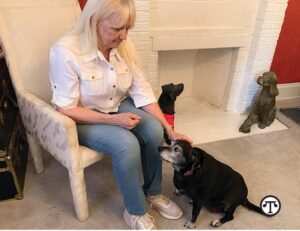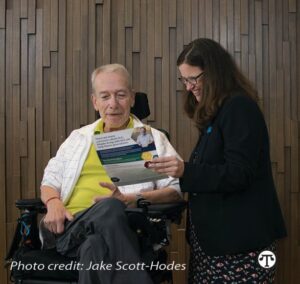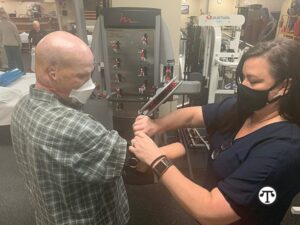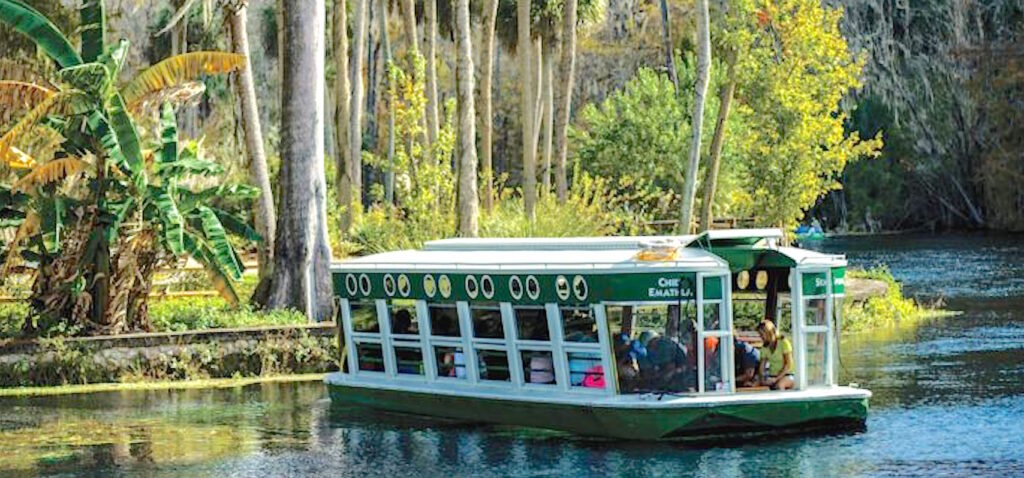Health, Home & Family
(NAPSI)—For the approximate 23 million women who balance caring for an aging parent with going to work, and often raising children of their own, there is little recognition and not enough support. These women themselves often don’t think of what they do as caregiving; they just consider themselves dutiful daughters. Yet they average 24.4 hours of unpaid care a week, from buying groceries, to managing medication, helping with household chores, assisting their parents with bathing and dressing, and driving to appointments. Many are even providing complex medical tasks, with little or no training, such as administering injections, monitoring vital signs, caring for wounds or cleaning feeding tubes. Collectively, they provide $470 billion in unpaid care, according to the AARP.
Often, these women provide this care at great cost to their careers. Working daughters, much like working mothers, may need to switch to a less demanding job, take time off or quit work altogether. They lose wages and job-related benefits costing them, on average, $304,000 in lost wages and benefits while spending nearly 20 percent of their own income on caregiving.
To give these unsung heroes recognition and much needed support, it’s important to make the care they give compatible with their careers. With 10,000 people turning 65 every day in the United States, the caregiving workforce is only going to grow. Smart businesses must examine policies and corporate cultures to create environments where caregivers can thrive. Working daughters need flexibility, paid family leave policies and expanding eligibility requirements. They need affordable, quality eldercare options.
Learn more at www.workingdaughter.com.
(NAPSI)—If you have a job—or wish you did—or a child in school, a new way of looking at technology, education and the world of work may prove good news for you.
COVID-19 has deeply affected both the American workforce and higher education, with community college enrollment down nationwide. This poses a dire challenge, as community colleges serve as a critical pipeline in making universities and advanced fields accessible to a broader population, while also exposing students to new educational pathways across various industries. With enrollment down and workforce numbers at a tipping point, these institutions of opportunity need momentum to drive motivation back to where it was before the pandemic—starting with the next generation of diverse advanced manufacturing workers.
Thanks to explosive growth in such sectors as flexible hybrid electronics (FHE), in the next few years industry leaders will serve as intermediaries between technical fields of the future and the workforce that’s needed. Equipping community colleges with programs that serve this transition will help bolster a new American workforce, powered by advanced manufacturing and FHE and other technology. Increased demand for both awareness-boosting and skill-building programs will help drive technology development and subsequent commercial proliferation of FHE and the greater advanced manufacturing industry.
While the tech workforce hasn’t been immune to disruption from COVID-19, it remains a field expected to have one of the biggest demands for a skilled workforce in the future. The pandemic has temporarily reduced that workforce; there’s a promising future for advanced manufacturing in 2021 and beyond. Continue reading
 (NAPSI)—Many older Americans say they feel depressed—yet the majority of them are not planning to get help, according to a new national survey—though it could make a tremendous difference in their health and well-being.
(NAPSI)—Many older Americans say they feel depressed—yet the majority of them are not planning to get help, according to a new national survey—though it could make a tremendous difference in their health and well-being.
With the onset of colder weather, fewer daylight hours, and the effect of the pandemic on holiday celebrations and traditions, more seniors than ever could be struggling with depression.
The GeneSight Mental Health Monitor reported that about two-thirds of adults 65 and older who are concerned they may be suffering from depression say they won’t seek treatment. That’s compared to fewer than half of adults over age 18. In addition, three in 10 of these older adults think “they can just snap out of it.”
“The ‘pull yourself up by your bootstraps’ mindset and reluctance to talk about mental health may be preventing seniors from getting the help they need,” said Dr. Mark Pollack, chief medical officer of Myriad Neuroscience, makers of the GeneSight test, a genetic measure that identifies potential gene-drug interactions for depression medication. “People seek treatment for conditions like heart disease, high blood pressure or diabetes. Depression is no different. It is an illness that can and should be treated.”
One GeneSight patient, Carmala Walgren, a 74-year-old resident of New York, agrees that depression should be treated regardless of age.
“There is such a stigma about depression among people my age,” said Walgren. “It is worth it to find treatment that helps you.” Continue reading
 (NAPSI)—Amyotrophic lateral sclerosis (ALS) is a fatal neurological disease that attacks the nerve cells. It first gained national attention as Lou Gehrig’s disease, named after the famous baseball player who was diagnosed with ALS in 1939. To date, the cause of ALS is unknown, and there is still no known cure. The disease strikes quickly, usually leading to death within 2–5 years of diagnosis. But every person with ALS has an individual story, and understanding these stories will help researchers ultimately piece together clues about the disease.
(NAPSI)—Amyotrophic lateral sclerosis (ALS) is a fatal neurological disease that attacks the nerve cells. It first gained national attention as Lou Gehrig’s disease, named after the famous baseball player who was diagnosed with ALS in 1939. To date, the cause of ALS is unknown, and there is still no known cure. The disease strikes quickly, usually leading to death within 2–5 years of diagnosis. But every person with ALS has an individual story, and understanding these stories will help researchers ultimately piece together clues about the disease.
Ed Tessaro was diagnosed with ALS in 2009. As he learned to cope with this diagnosis, he reflects, “I’ve never considered myself a victim of the disease, because I believe in my heart all of us have a wheelchair. In my case, it’s quite literal, but with everything that goes on in my life, I realize that every family has had a crisis.” One of the things that helps him and others with ALS is reaching out for community support and resources. “The ongoing struggle is to encourage newly diagnosed people to come in and talk about their condition. I want to help people learn about the National ALS Registry, clinical trials, and other resources that can provide support and hope.”
The National ALS Registry helps gather information from those who are living with this disease. Researchers from all around the world can access the Registry data to help scientists learn more about what causes this disease. Everyone’s story is different, and everyone’s piece of the puzzle is essential. The Registry has found that more than 16,000 people with ALS live in the United States. It is important to include as many people as possible living with the disease to get the most accurate information. When patients join, it helps give researchers more information. This could lead to a better understanding of the causes of ALS, because learning more about the disease is one step further in the battle to defeat it.
If you or someone you care about has ALS, consider learning more about the National ALS Registry by visiting: www.cdc.gov/als.
 (NAPSI)—The Elizabeth Dole Foundation and U.S. Department of Veterans Affairs have launched an emergency respite care fund for the family caregivers of wounded, ill, and injured veterans. The program, Respite Relief for Military and Veteran Caregivers, will provide non-medical, no-cost, professional home care to veteran caregivers who are struggling during the COVID-19 pandemic. CareLinx, a nationwide professional home care network, helped launch the fund with a donation of $1 million worth of services. Wounded Warrior Project then contributed an additional $1 million to expand the program. The Foundation expects to provide 75,000 hours of care to more than 3,000 veteran caregivers.
(NAPSI)—The Elizabeth Dole Foundation and U.S. Department of Veterans Affairs have launched an emergency respite care fund for the family caregivers of wounded, ill, and injured veterans. The program, Respite Relief for Military and Veteran Caregivers, will provide non-medical, no-cost, professional home care to veteran caregivers who are struggling during the COVID-19 pandemic. CareLinx, a nationwide professional home care network, helped launch the fund with a donation of $1 million worth of services. Wounded Warrior Project then contributed an additional $1 million to expand the program. The Foundation expects to provide 75,000 hours of care to more than 3,000 veteran caregivers.
“The lack of affordable, convenient, professional respite care has always taken a significant toll on the emotional and physical well-being of veteran caregivers,” said Steve Schwab, CEO of the Elizabeth Dole Foundation. “Now, due to the increased health risks and limitations created by the pandemic, we are seeing a spike in the need for short-term relief.”
Even as states re-open, some of the most critically wounded or ill veterans and their caregivers will have a long journey back to the pre-pandemic world. These veterans often have vulnerable immune systems that require their caregivers to take every precaution against exposure. By asking family and friends to keep their distance, they are losing a vital source of daily support.
“We are grateful to CareLinx and Wounded Warrior Project for helping us respond to this urgent need,” Schwab continued. “We hope other organizations also step up, so we can ensure every veteran caregiver suffering during COVID-19 receives the help they need.”
The program is rolling out in select regions and will expand nationwide over time. Eligible caregivers can request services that include companionship, grocery shopping, cooking, mobility assistance, transportation, bathing, and other activities of daily living. AARP and Bob Woodruff Foundation have also joined as key collaborators for this effort to help spread the word to military and veteran caregivers.
To learn more and apply, visit www.hiddenheroes.org/respite.
Folks have been seeking the clear waters of Marion County for millennia.
But it was in the years following the Civil War that Silver Springs began to attract tourists from the North via steamboats up the Silver River, according to the website for Silver Springs State Park.
It wasn’t until the late 1870s that Hullam Jones and Phillip Morrell fixed a piece of glass to the bottom of a rowboat and created the first glass bottom boat.
Col. W.M Davidson and Carl Ray, who acquired rights to the springs, near Ocala, in 1924, perfected a gasoline-powered version of the glass bottom boat.
About 20 movies were filmed there, including “Rebel Without a Cause,” starring James Dean, “Distant Drums,” starring Gary Cooper, the James Bond movie “Moonraker,” “Creature from the Black Lagoon” and six Tarzan flicks, according to the website. Episodes of television shows such as “Sea Hunt” also were filmed.
Piesanos Stone Fire Pizza
8075 SW 200 Hwy, Suite 101
Ocala, FL 34481
A beautifully decorated with the ambiance of a five star restaurant. This is not a pizza dive, it possesses the finer qualities of dining at a reasonable price. The menu offers many Italian speciality favorites, salads, deserts and pizza. The hostess, waitress/waiter and management, exceeds expectations, to make you feel appreciated.
After being seated, our waitress Felicity, explained the specials for the evening and took our drink order. She returned with our beverages and took our pizza order.
She returned with the complementary fresh baked dinner rolls, drizzled with Italian Dressing and spices. The dinner rolls alone, will make you return to this restaurant.
We ordered 1/2 pepperoni and 1/2 mushroom pizza. The sauce had a light sweet taste, with fresh mozzarella and generous toppings. The crust was perfectly cooked with a light crunch from the center to the crust, no soggy dough.
Piesanos has already made my return list. A placed to be pampered by the wait staff and fresh delicious ingredients prepared into a meal by their master chefs! Continue reading
(NAPSI)—Hurricane season officially runs through November, and while no one can predict what lies ahead, there are things you can do to prepare. Here, T-Mobile offers eight ways to stay connected.
1.Make a disaster kit: Include things such as batteries, snacks, water, a first aid kit, a flashlight and device chargers.
2.Update your family, friends and emergency services contact numbers. Make sure they’re saved and backed up in your devices AND written down someplace accessible.
3.Subscribe to official text alerts and connect with official social networks to learn about new developments before, during and after a disaster.
4.Keep your mobile devices fully charged. Have charging cables handy and consider picking up a car or portable charging device.
5.Protect your technology with waterproof re-sealable plastic bags.
6.Download emergency-assistance apps from the Red Cross and FEMA.
7.Make sure your phone supports Wireless Emergency Alerts and that you have enabled notifications on your device. Visit t-mobile.com/wea for details on how to set up alerts on T-Mobile and Sprint devices.
8.Set up Wi-Fi Calling on your phone if you have a phone that supports it. For Apple phones, go to Settings > Phone > Wi-Fi Calling; for Android phones, go to Settings > More Connection Settings > Wi-Fi Calling. Continue reading
(NAPSI)—As the summer months wind down, many will continue to flock outdoors and enjoy outdoor activities like hiking, camping, and fishing. What you may not realize is that despite the weather cooling off, ticks are still very prevalent outdoors.
It is important to check for ticks after spending time in the grass or garden, as ticks can transmit a bacterial infection known as Lyme disease.
The Disease
A bull’s-eye rash is one of the hallmarks of Lyme disease, but other symptoms can be non-specific and even overlap with symptoms of COVID-19. These include body aches, fever, breathlessness, eye pain, diarrhea, chest tightness, headache, fatigue or joint pain.
According to the Global Lyme Alliance, there are approximately 427,000 new cases of Lyme disease in the United States every year. However, Lyme disease is often missed—or misdiagnosed—due to unreliable testing. In fact, only 30% of people with early Lyme infections have a positive test result with existing tests because the disease is difficult to detect in its earliest stages, even though this is when it is easiest to treat.
If you suspect you have Lyme disease or have been recently diagnosed, you can be part of the solution to improve detection of the disease in others. Continue reading




